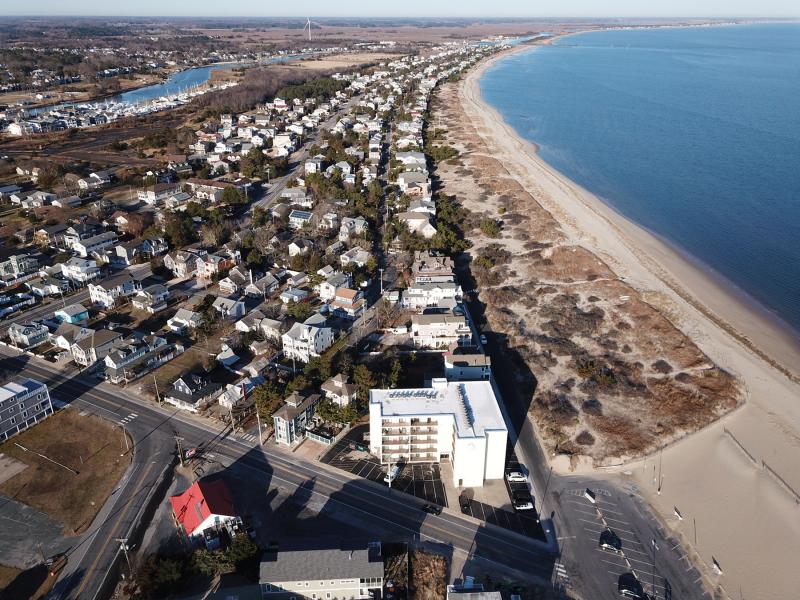With interest in setting up a resiliency fund for Lewes, the city’s executive committee on resiliency welcomed officials from Coral Gables, Fla., Feb. 22, to discuss their approach.
Coral Gables is a coastal city of 50,000 residents just south of Miami. Although it does not have beaches, it is adjacent to the Atlantic Ocean with many waterfront properties, and is very vulnerable to sea-level rise and the impacts of climate change.
In 2016, the city established its sea-level rise fund to address future projects and improvements. The fund is using small, annual, incremental increases to stormwater fees over a 10-year period to build its amount to about $100 million by 2040. When increases end in 2026, the city will be accumulating just over $5 million a year.
“That $100 million is pure principal as collected,” said Keith Kleiman, assistant finance director for management, budget and compliance. “But, we are investing it, and it should be considerably more than $100 million by 2040.”
The money is not to be used for emergency purposes if a hurricane or other natural disaster occurs. Coral Gables has built funding for those occurrences into its operating reserve.
“The city maintains a 25 percent reserve,” Kleiman said. “In our case, between $40 million and $45 million does not get touched unless there’s some catastrophe.”
The last big storm to hit Coral Gables was Hurricane Irma in 2017, which caused about $20 million in damage. The city used the money in its reserve to pay for that recovery and cleanup.
“Most of it comes back to us from [the Federal Emergency Management Agency], the state or our insurance policies,” Kleiman said. “Any amount we have to absorb is then taken out of our annual surpluses as they come to us, to restore the reserve to 25 percent.”
The sea-level rise fund is to be used for future projects and improvements, although the city has no idea what those will be just yet.
“We’re looking for this money to go toward permanent fixes,” Kleiman said. “We don’t know what those fixes are yet. We are probably looking toward the Army Corps of Engineers, who I know are working on items all over the country. We are waiting on them.”
Matt Anderson, the resiliency and sustainability manager for Coral Gables, said the fund will likely be used as seed money for matching grants from federal and state governments.
“$100 million sounds like a lot of money, but it’s really a drop in the bucket when it comes to funding resiliency,” he said. “We know it’s going to be an expensive endeavor, and cities across the country are going to be looking at funding to be able to make their cities more resilient.”
Following the Coral Gables presentation, the committee discussed a resiliency fund for Lewes, including what it would be used for and how to fund it.
Jen Reitz, a principal planner with the University of Delaware’s Institute for Public Administration, provided a list of possible funding sources. In addition Coral Gables’ approach of increased stormwater fees, Reitz listed real estate transfer taxes, accommodations tax, building permit fees, property tax increase, bonds and a developer impact fee as possible sources. Philip Barnes, a policy scientist with UD’s Institute for Public Administration, noted that the Town of Bethany Beach has increased property taxes to fund a disaster-relief fund. Officials from Bethany Beach are set to discuss the fund at the Lewes resiliency committee’s next meeting Tuesday, March 8.
Mayor Ted Becker said Lewes does not have a separate disaster-relief fund currently, but the city’s mitigation planning team is working on it.
Committee member Tom Panetta, who is also a Lewes Board of Public Works member, said the BPW keeps a cash reserve in all four of its utilities to be used for capital projects and disaster recovery. Together, the cash reserves total about $13 million, he said. It’s important to have money on hand in case of an emergency, he said.
“Coral Gables is correct that FEMA will eventually reimburse you, but the FEMA reimbursement cycle is one to two years, so you need to have cash on hand if you want to get contractors to come in and assist you after a disaster,” he said.
He noted that the BPW’s cash reserves only take into account utility infrastructure; they would not be enough to cover the city’s responsibilities for roads and other recovery efforts.
The resiliency committee is expected to continue discussing a resiliency fund at its March 8 meeting. The goal is to eventually recommend the framework of a fund to mayor and city council. A link to the meeting can be found on the agenda at lewes.civicweb.net.













































